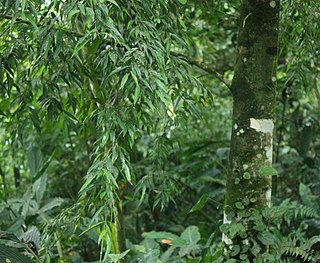
Saccharum is a genus of tall perennial plants of the broomsedge tribe within the grass family.

Ficus benghalensis, commonly known as the banyan, banyan fig and Indian banyan, is a tree native to the Indian Subcontinent. Specimens in India are among the largest trees in the world by canopy coverage. It also known as the "strangler fig" because it starts out as epiphyte, that is, leaning on another tree that it ends up suffocating.

Ficus benjamina, commonly known as weeping fig, benjamin fig or ficus tree, and often sold in stores as just ficus, is a species of flowering plant in the family Moraceae, native to Asia and Australia. It is the official tree of Bangkok. The species is also naturalized in the West Indies and in the states of Florida and Arizona in the United States. In its native range, its small fruit are favored by some birds.

Ficus microcarpa, also known as Chinese banyan, Malayan banyan, Indian laurel, curtain fig, or gajumaru (ガジュマル), is a tree in the fig family Moraceae. It is native in a range from China through tropical Asia and the Caroline Islands to Australia. It is widely planted as a shade tree and frequently misidentified as F. retusa or as F. nitida.

Cauliflory is a botanical term referring to plants that flower and fruit from their main stems or woody trunks, rather than from new growth and shoots. This can allow trees to be pollinated or have their seeds dispersed by animals that climb on trunks and sturdy limbs to feed on the nectar and fruits. Plants may instead have fruit which drop from the canopy and ripen only after they reach the ground, an alternative "strategy" to cauliflory.

The Acharya Jagadish Chandra Bose Indian Botanic Garden, previously known as Indian Botanic Garden and the Calcutta Botanic Garden, is situated in Shibpur, Howrah near Kolkata. They are commonly known as the Calcutta Botanical Garden and previously as the Royal Botanic Garden, Calcutta. The gardens exhibit a wide variety of rare plants and a total collection of over 12,000 specimens spread over 109 hectares. It is under Botanical Survey of India (BSI) of Ministry of Environment and Forests, Government of India.

Ficus nota is a species of flowering plant in the family Moraceae. It is commonly known as tibig or sacking tree, is a species of fig tree found near water in low altitudes. Tibig is native to the Philippines. They are also found in parts of northern Borneo in Malaysia.The tree can grow up to 9 meters high. It is primarily dispersed by birds which eat the fruits and excrete the seeds. The fruits are also edible to humans, although they are rather bland. They are usually eaten with sugar and cream in the Philippines. The young leaves are also eaten as a vegetable.
Ficus crassiuscula is a species of flowering plant in the family Moraceae, native to Central America and north-western parts of South America.

Ficus fraseri, the white sandpaper fig or shiny sandpaper fig, is one of several fig species commonly known as sandpaper figs. It is native to New South Wales, Queensland and the Northern Territory in Australia and to New Caledonia and Vanuatu. Other common names are "figwood" and "watery fig".

Schmidtia is a genus of Asian and African plants in the grass family.

The fig is the edible fruit of Ficus carica, a species of small tree in the flowering plant family Moraceae. Native to the Mediterranean and western Asia, it has been cultivated since ancient times and is now widely grown throughout the world, both for its fruit and as an ornamental plant. Ficus carica is the type species of the genus Ficus, containing over 800 tropical and subtropical plant species.

Ficus pseudopalma is a species of fig in the family Moraceae. It is known by the common names Philippine fig, dracaena fig, and palm-leaf fig. In nature it is endemic to the Philippines, especially the island of Luzon. It is known elsewhere as an ornamental plant.

Ficus palmata, the Punjab fig, or "Bedu" is a plant in the family Moraceae.
Stipagrostis hirtigluma is a densely tufted perennial grass. It occurs across most of Africa east to Pakistan in bushveld, karoo, and desert regions. In Namibia, it grows in dry, warm parts, in stony or sandy places and on rocky outcrops.
Ficus assamica is a species of flowering plant in the genus Ficus, native to the foothills of the Himalayas, Assam, south-central China, and mainland Southeast Asia. It is a recumbent or creeping shrub reaching at most 60 cm.
Ficus morifolia can refer to:

Ficus saussureana, commonly known as the loquat-leaved fig, loquat-leaf fig, old Calabar fig, or nonko, is a species of flowering plant in the fig family. It is native to west and central Africa, with a native range spanning Guinea to South Sudan, western Kenya, and northwestern Tanzania. Ficus saussureana is an arboriform species that grows up to 20m tall with a broad crown. Leaves are arranged in spirals, and are entire. Fruits form just below the leaves in twos or threes, and grow to a diameter of 2-4cm. Pests include Greenidea ficicola, a species of aphid, and Psacothea hilaris, a species of beetle.
Ficus sciaphila is a species of flowering plant, a tree in the family Moraceae. It is closely related to Ficus copiosa.

Ficus virgata, commonly known as figwood, is a tree in the family Moraceae, native to areas of Southeast Asia and the western Pacific. It grows as a strangler on other trees, eventually smothering and killing its host.

Ficus celebensis, the weeping fig or willow-leaved fig, is a species of flowering plant in the family Moraceae, endemic to the Minahasa Peninsula of Sulawesi. A tree reaching 25 m (82 ft), it is rare on its native island, but is occasionally planted as an ornamental elsewhere, such as Hong Kong, Singapore, and Australia.














